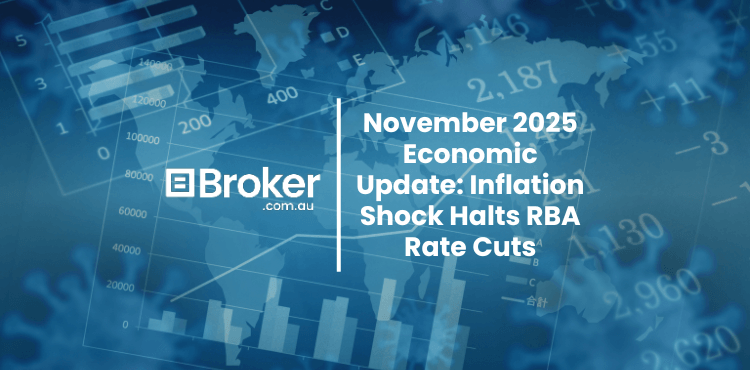RBA (finally!) cuts official cash rate
The headline story for August was the Reserve Bank of Australia’s (RBA) decision to lower the official cash rate by 25 basis points, bringing it down to 3.60%.
In July, the RBA surprised markets by holding steady, despite strong expectations of a cut. At the time, the Bank cited the importance of waiting for quarterly inflation data rather than relying solely on monthly CPI. That data has now arrived.
Annual underlying inflation eased to 2.7% in the year to 30 June 2025, slightly lower than the 2.9% recorded in March and the softest outcome since late 2021. This result aligned closely with market expectations and reinforced the RBA’s view that inflation is now well within its 2–3% target band.
Looking ahead, economists expect inflation to continue moderating. All four major banks see another 25 basis point cut by November. Westpac forecasts an additional two cuts by May 2026, while NAB expects the next move could come as early as February. ANZ is more cautious, predicting the November cut could be the last before 2027. Commonwealth Bank has not yet provided projections beyond this year.
Recent remarks on economic sentiment by RBA Governor Michele Bullock
Living standards & productivity
In the RBA’s most recent quarterly monetary policy statement (early August 2025), Governor Bullock highlighted that persistently weak productivity growth, subdued wage growth, declining consumer spending, and shrinking business profits are expected to drag down living standards in Australia. She reiterated that while the RBA can help maintain low inflation and employment, it cannot directly fix structural productivity issues. Quite an interesting comment from the Governor here … I think this is a sign that we should all keep a close eye on both domestic and global activity.
Consumer sentiment responds positively to rate cuts
Consumer sentiment is showing renewed improvement, propelled by the RBA’s third rate cut of the year, which lowered the cash rate to 3.60%. According to a Westpac–Melbourne Institute survey:
- Sentiment rose 5.7% to 98.5, its highest level since early 2022—though still below the neutral benchmark of 100.
- Key indicators improved: the one-year economic outlook rose 7.6%, and the five-year outlook improved 5.4%.
- Households felt better about their current finances and future purchasing—including a 10.5% jump in perception of it being a good time to buy a home.
In these remarks, Governor Bullock underscored a cautious sense of optimism—with sentiment recovering, but affordability issues still evident.
If you’re considering buying or refinancing, start your application here.
Productivity forecasts revised lower
In its latest Statement on Monetary Policy, the RBA reduced its assumption for medium-term labour productivity growth from 1.0% to 0.7% per annum.
The Bank attributed the downgrade to several structural challenges, including weaker business competition, slower adoption of new technologies, reduced investment per worker, and regulatory barriers in sectors such as construction. The growing share of lower-productivity industries like health and education has also weighed on overall output.
Sluggish productivity is a concern because it limits the economy’s capacity to grow. When output per worker rises slowly, it suppresses wage growth, which in turn constrains household consumption and overall demand. This “knock-on” effect can significantly drag on long-term economic expansion.
While the RBA still expects inflation and unemployment (currently 4.2%) to remain in favourable territory, weaker productivity is projected to dampen both private spending and public finances. Similar trends are evident in other advanced economies, underscoring the scale of the challenge.
Rate cuts are therefore expected to play a key role in supporting demand while these headwinds persist.
Housing supply constraints keep prices climbing
The housing market continued its upward run, with national dwelling prices rising 0.6% in July, according to Cotality’s Home Value Index. This marked the sixth straight month of growth, with every capital city recording gains. Darwin led with a 2.2% lift, followed by Perth (0.9%) and Brisbane (0.7%).
On the supply side, private house approvals fell 2.0% in June after a 1.0% dip in May. Queensland (-6.3%) experienced the largest drop, followed by South Australia (-2.6%) and New South Wales (-2.4%).
Despite this, overall dwelling approvals rose 11.9% in June, building on a 2.2% increase the previous month — indicating ongoing resilience in multi-unit projects.
Explore your finance options early to stay ahead of rising prices. Begin your application here.
Global backdrop
Uncertainty remains high in the international economy. While fears of severe U.S. tariff outcomes have eased, trade policy changes still carry risks for global growth.
At the same time, central banks worldwide are managing a delicate balance: supporting economies that are losing momentum, while ensuring inflation, though easing, continues to trend lower.
With rate cuts underway and housing market shifts continuing, now’s the time to prepare. Apply online here to get started.




